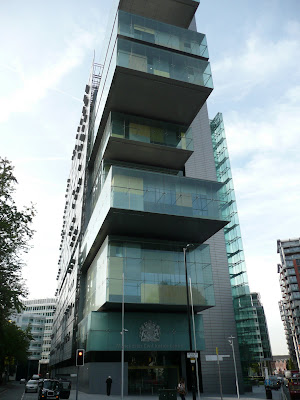
I am back home after a week in the northwest, catching up with old friends, visiting cousins, and tracing some family roots.
When I was a child growing up in Bolton, nearby Manchester was the big city where we went for special treats, Christmas shopping, orchestral concerts, pantomime, and the occasional light opera performances. It was also the city where my paternal grandfather had worked, where my parents met, and where many years later I would start my BBC career.
This is the well restored building in George Street where my grandfather Richard had an office from which he ran his small cotton trading business. He also traded on the world famous Royal Exchange in St. Annes Square.
The Exchange (above) is a remarkable building, opened in the early 1800’s, which grew and was extended, until it became the largest trading hall in the world. The decline of Lancashire’s position as the cotton centre of the world meant that its role ceased and it finally closed in the late 1960’s. It lay empty for some years until the 69 Theatre Company constructed a temporary theatre which I recall Liz and I attending in 1973. It was constructed largely of scaffold and canvas and we all sat on timber planks. Even in that rough-and-ready form you had a sense of a most exciting and intimate performance space, a theatre in the round housed inside this enormous ‘parent’ building.
Stage designer Richard Negri conceived the form and scale of the original, and architects Levitt Bernstein Associates developed this, with the theatre company, into the remarkable Royal Exchange Theatre, which opened in 1976.
In June 1996 the Company was displaced after the building suffered serious damage from the IRA bomb which devastated much of central Manchester. We were able to give the theatre company a home for a few weeks at the BBC in Oxford Road, before they created a temporary home in Castlefield. The restored Exchange building and improved theatre reopened in November 1998.
The whole structure of the 750 seat theatre ‘capsule’ is carried on four giant trusses, the weight being transferred to the four columns which carry the roof of the original Exchange building.
Manchester has been careful in it's central development, saving many impressive older buildings, which the city has restored; there are also some striking newer ones.
As a child I attended concerts by the Halle Orchestra at the Free Trade Hall. The restored facade has been retained and behind it archietcts Stephenson Bell have created a Radisson hotel.
The Crown Courts 1961, designed by Leonard C Howitt, Manchester City Architect.
Civil Justice Centre 2007, by architects Denton Corker Marshall
My parents met when they were both working at the Manchester Royal Infirmary of which St Mary’s is a part.
Part two of 'Up North' will follow shortly







No comments:
Post a Comment